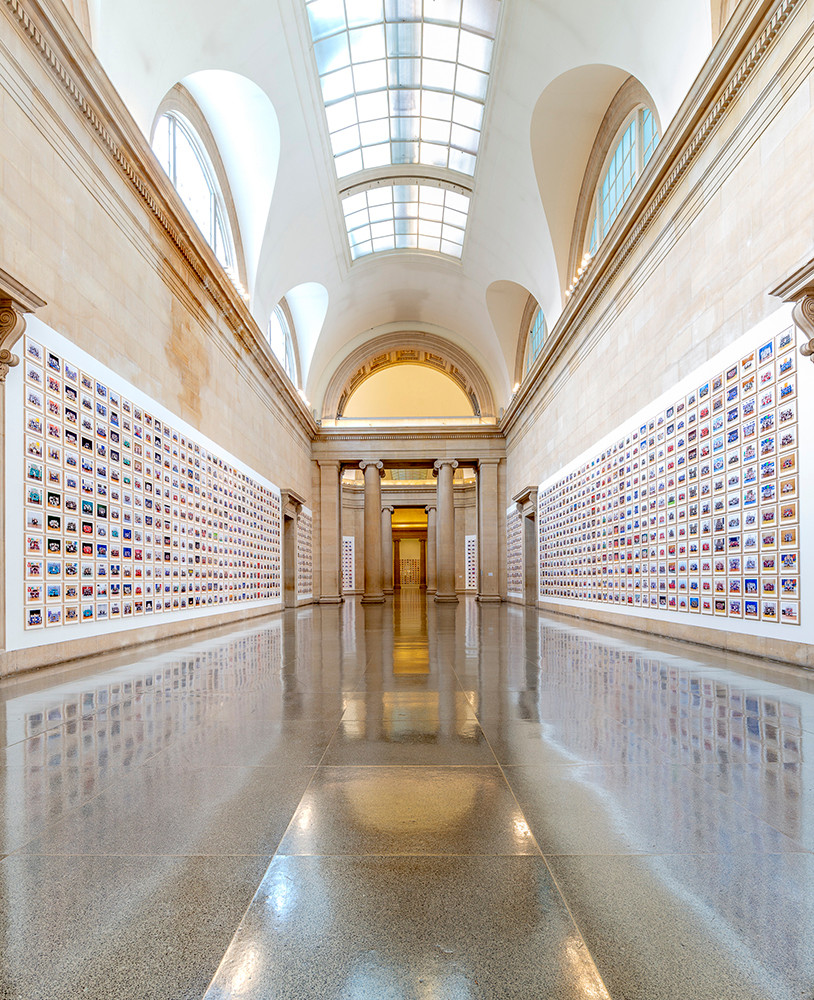[ad_1]
In the past two decades, artist-filmmaker Steve McQueen has achieved Hollywood success with movies that draw on the spirit of video art—a rare feat. His Academy Award-winning 12 Years a Slave (2013) was an adaptation of the 1853 memoir of Solomon Northrup—a freeborn man who, in his thirties, was kidnapped and sold into slavery—that employed disjointed editing schemes and overlapping sound design, stylistic devices associated more with experimental film than with mainstream movies. At the same time, the works McQueen makes for the gallery have a cinematic quality. He won the Turner Prize in 1999 for a group of films that critiqued the invisibility of black identity in cinema and reflected on his own identity as the son of working-class immigrants from the Caribbean island of Grenada who settled in west London. In Deadpan (1997), for instance, McQueen repeatedly restaged an iconic stunt from Buster Keaton’s 1928 silent film Steamboat Bill, Jr., in which Keaton manages to walk away unscathed after a house falls on top of him during a storm.
McQueen’s retrospective at Tate Modern comprised fourteen works that demonstrated his commitment to the ostracized, the ignored, and the colonized. Projected onto the museum’s facade, one channel of the twenty-nine-minute two-channel film Caribs Leap (2002) features Edenic views of islanders in Grenada enjoying a swim, seemingly oblivious to the presence of the camera filming them. In the second channel, shown on a screen in the exhibition, figures fall endlessly against a blue backdrop that resembles both sea and the sky, the footage evoking an episode from the history of the island, which was colonized by the French in 1650 and ceded to the British in 1763 before gaining independence in 1973. The eponymous Caribs’ Leap is a tall cliff overlooking the Caribbean Sea from which Grenada’s Indigenous Caribs leapt to their death rather than surrendering to the invading French. As McQueen told Rolling Stone in a 2014 interview, he has long been fixated on the way the Caribs “transcended themselves” through the act. In the video, the history of the Caribs seems to seep into the present time, making clear that Grenadian identity continues to be defined by colonial history.
Some works in the exhibition were screened to small groups of people every half-hour, requiring would-be viewers to queue in advance; no entry was allowed mid-screening. One such work was 7th Nov. (2001), and the immersive, communal viewing conditions—which resembled those of cinema screenings rather than typical presentations of video art—heightened its harrowing quality. The piece is a twenty-three-minute slide projection of a single 35mm photograph of McQueen’s cousin Marcus lying on his back, displaying a scar on his head, with a voice-over monologue in which Marcus describes how he accidentally shot his brother while trying to engage the safety on his gun. The work’s title refers to the date of his death. The combination of the static slide on-screen and the avalanche of vivid images described in the monologue—from the victim’s cheerful arrival at Marcus’s apartment to the police raid in which Marcus is detained as a murder suspect—echoes the tension between action and stasis Marcus experienced during his ordeal.
There is a striking contrast between the stillness of 7th Nov. and the dizzying motion of Static (2009), a defamiliarizing portrait of the Statue of Liberty shot from a circling helicopter. The loud whirring of helicopter blades and the close-up shots of the statue’s surface produce a sense of anxiety, giving the film militaristic overtones. Shot from New York Harbor following the reopening of the Statue of Liberty after it had been closed for eight years since the 9/11 attacks, Static captures signs of structural decay and bird-shit stains marring the purported symbol of American freedom, a reminder of the Islamophobia, racism, and policing of US borders that followed the terror attacks.
The show’s sole sculpture, Weight (2016), reimagines Oscar Wilde’s prison-bed frame at Reading Gaol (now HM Prison Reading), where Wilde was incarcerated in 1895 after a London court found him guilty of “gross indecency”—a charge referring to sexual activity between men. A gold-plated mosquito net surrounding the metal prison bed brought to mind Wilde’s aphorism “We are all in the gutter, but some of us are looking at the stars.” Wilde wrote some of his best works from his prison cell, such as De Profundis (1897) and The Ballad of the Reading Gaol (1897), articulating the conflicting pressures of self-expression and social marginalization. Juxtaposing the glittering gold net with the squalid prison bed, the sculpture—first displayed in Reading Prison’s cells in 2016 to mark the fiftieth anniversary of the decriminalization of homosexuality in Britain—serves to remind viewers of the contested nature of British identity.
In conjunction with the Tate Modern show, Tate Britain presented an installation of McQueen’s Year 3 project (2019), which comprises 3,128 photographs of third-grade classes at state, faith-based, independent, and special schools across London. The images, which were shot by Tate photographers, capture roughly two thirds of London’s population of seven- and eight-year-olds. Originally presented on billboards across London in November 2019, they lined the gallery walls at Tate Britain at much smaller scale. The sociological portraits register how class and race affect London’s youth: some of the uniforms are visibly nicer, some classrooms are more multiracial. While certain critics have written off the project as a feel-good effort that nods at these questions without engaging with their structural causes, McQueen’s photographs poignantly highlight the social and political knots that these young Londoners will face in the coming decades. As these children make their way in the world, how many of them will suffer discrimination? Who will flourish thanks to their privileged beginnings? How will the social forces of Brexit Britain forge their lives? With McQueen’s trademark subtlety, the portraits ask viewers to reckon with Britain’s future.
[ad_2]
Source link


